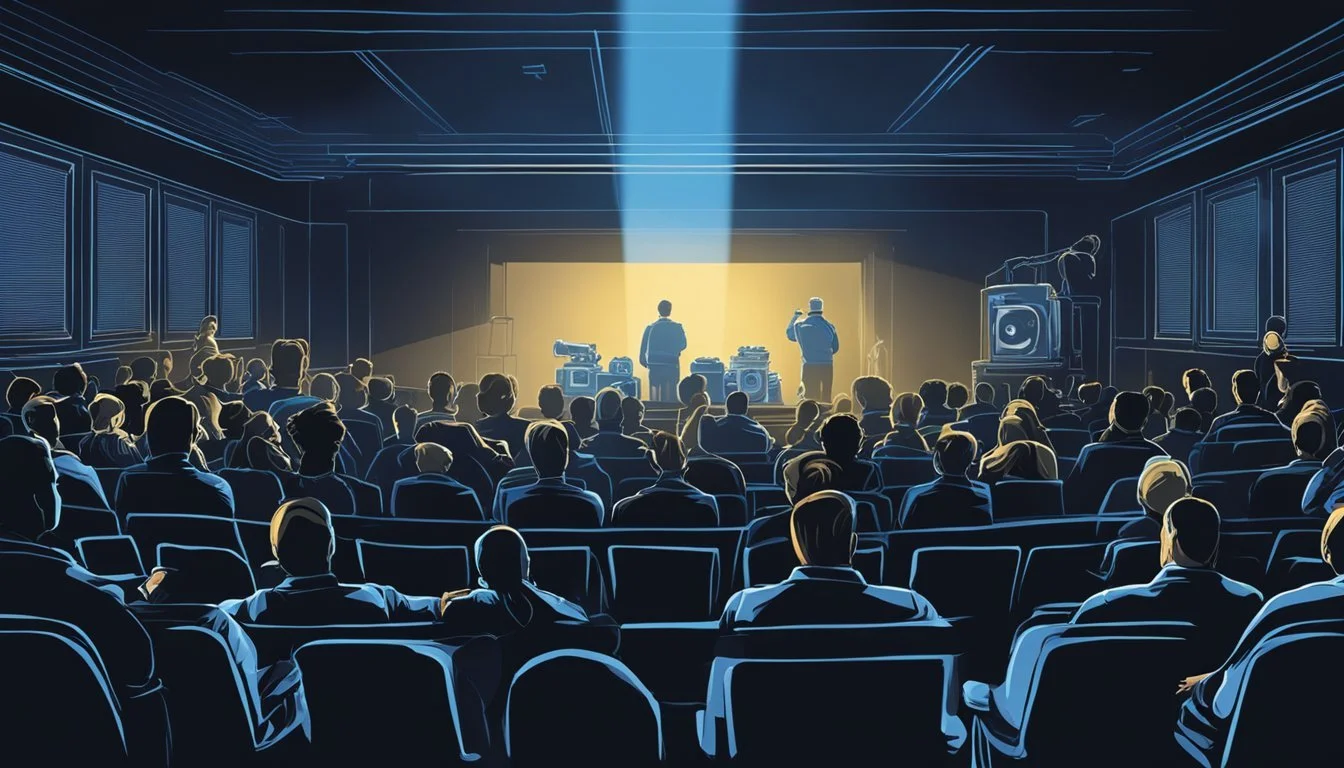Shocking Exposé: How the 'Thin Blue Line' Documentary Uncovered a Justice Scandal!
The Thin Blue Line, a groundbreaking 1988 documentary by Errol Morris, exposed a grave miscarriage of justice in the American legal system. The film meticulously examines the case of Randall Dale Adams, who was wrongfully convicted and sentenced to death for the 1976 murder of a Dallas police officer. Morris's innovative use of reenactments, interviews, and a haunting musical score challenged the prosecution's evidence and ultimately led to Adams's exoneration.
Through a series of compelling interviews and dramatic recreations, the documentary presents a detailed account of the crime and subsequent investigation. It raises serious questions about the reliability of eyewitness testimony and the potential for corruption within the justice system. The film's powerful narrative structure and thought-provoking content captivated audiences and critics alike.
The Thin Blue Line's impact extended far beyond the realm of cinema. Its revelations played a crucial role in overturning Adams's conviction, demonstrating the profound influence documentaries can have on real-world events. This landmark film continues to be studied and celebrated for its contributions to both the documentary genre and the ongoing dialogue about criminal justice reform.
Background of the Documentary
"The Thin Blue Line" emerged as a groundbreaking documentary that reshaped the true crime genre and impacted the criminal justice system. Errol Morris directed this influential film, which delved into the controversial murder case of Dallas police officer Robert W. Wood.
Concept and Development
Errol Morris initially set out to create a film about Dr. James Grigson, a psychiatrist known as "Dr. Death" for his testimony in death penalty cases. During his research, Morris became intrigued by the case of Randall Dale Adams, who was convicted of murdering Officer Wood in 1976.
The filmmaker's interest shifted to investigating Adams' conviction. Morris conducted extensive interviews and gathered evidence that cast doubt on Adams' guilt. He employed innovative techniques, including dramatic reenactments, to present the case's complexities.
These reenactments sparked debate within the documentary world. Some criticized the blurring of fiction and reality, while others praised Morris' approach for enhancing the narrative and engaging viewers.
Key Personalities
Randall Dale Adams stood at the center of the documentary as the wrongfully convicted man. His story formed the backbone of Morris' investigation. David Harris, the actual perpetrator, also played a crucial role in the film's narrative.
Errol Morris himself became a key figure, not just as the director but as an investigative force. His persistent questioning and unique filmmaking style drove the documentary forward.
Dallas police officers and witnesses involved in the original case featured prominently. Their testimonies and recollections provided critical insights into the flawed investigation and trial process.
The film also highlighted the roles of lawyers, judges, and other legal professionals involved in Adams' conviction and subsequent appeals.
Synopsis of 'The Thin Blue Line'
'The Thin Blue Line' is a 1988 documentary film directed by Errol Morris. It focuses on the case of Randall Dale Adams, who was wrongfully convicted of murdering a Dallas police officer in 1976.
The film presents a detailed examination of the events surrounding the crime. It uses interviews with key witnesses and dramatic reenactments to reconstruct the incident.
Morris's documentary highlights the flaws in the investigation and judicial process. It reveals how circumstantial evidence and questionable testimonies led to Adams's conviction.
The film explores the pressure on law enforcement to solve the case quickly. This resulted in overlooking crucial details and potential alternative suspects.
Through its narrative structure, 'The Thin Blue Line' raises doubts about Adams's guilt. It presents compelling arguments for his innocence and points to another suspect as the likely perpetrator.
Key elements of the documentary include:
Interviews with witnesses and investigators
Reenactments of the crime scene
Analysis of evidence presented at trial
Examination of police procedures
The film's impact extends beyond storytelling. It played a significant role in reopening Adams's case, ultimately leading to his exoneration and release from prison.
Production Elements
Errol Morris employed innovative techniques to bring the story of Randall Dale Adams to life. His unconventional approach blended interviews, stylized reenactments, and a haunting musical score.
Interviews and Reenactments
Morris conducted extensive interviews with key figures involved in the case. He spoke with Adams, police officers, witnesses, and others connected to the investigation. These interviews provided firsthand accounts and conflicting perspectives.
To visualize crucial moments, Morris used dramatic reenactments. These stylized scenes recreated events like the shooting and police interrogations. The reenactments helped viewers understand the sequence of events and highlighted discrepancies in witness testimonies.
Morris avoided traditional documentary elements like narration or on-screen text identifying speakers. This unique approach immersed viewers in the story and allowed them to draw their own conclusions about the case.
Musical Score by Philip Glass
Renowned composer Philip Glass created the film's original score. His minimalist style perfectly complemented the documentary's tone and pacing.
Glass's repetitive musical phrases built tension throughout the film. The score enhanced the sense of mystery and uncertainty surrounding Adams's conviction.
The music became an integral part of the storytelling. It underscored key moments and tied together the various elements of interviews, reenactments, and archival footage.
Glass's haunting compositions added emotional depth to the documentary. They heightened the viewer's empathy for Adams and emphasized the gravity of his wrongful conviction.
Cultural and Legal Impact
"The Thin Blue Line" profoundly shaped both the legal system and public perception of documentary filmmaking. Its innovative approach and pursuit of truth led to significant real-world consequences.
Effect on the Criminal Justice System
The film's investigation into Randall Dale Adams' case exposed flaws in the criminal justice system. It revealed issues with eyewitness testimony and police conduct in Dallas County. The documentary's findings ultimately led to Adams' release from prison after serving 12 years for a crime he did not commit.
This outcome highlighted the power of investigative journalism and filmmaking to challenge legal verdicts. It sparked discussions about wrongful convictions and the need for reforms in evidence gathering and trial procedures.
Influence on Public Opinion and Cinema
"The Thin Blue Line" transformed public understanding of documentary filmmaking. Its use of reenactments, while controversial, became a widely adopted technique in true crime documentaries.
The film's success demonstrated the potential for documentaries to engage audiences with complex legal issues. It helped establish the true crime genre as a popular form of entertainment and social commentary.
Critics praised the film's innovative storytelling methods. Its impact extended beyond cinema, influencing how the public viewed the reliability of criminal convictions and the role of media in pursuing justice.
Critical Reception
"The Thin Blue Line" garnered widespread acclaim from film critics and industry professionals. The documentary received recognition for its innovative approach and impact on the genre.
Film Critics' Reviews
Film critics lauded "The Thin Blue Line" for its groundbreaking narrative style and investigative depth. The New York Times praised its "mesmerizing power" and ability to challenge conventional documentary filmmaking. Roger Ebert awarded it a perfect four-star rating, highlighting its compelling storytelling and meticulous research.
Critics commended Morris's use of dramatic reenactments, though some debated their place in documentaries. The film's blending of fiction and reality techniques sparked discussions about documentary ethics. Despite this, most reviewers agreed that the film's impact outweighed any stylistic concerns.
Awards and Nominations
"The Thin Blue Line" received numerous accolades from film institutions. The New York Film Critics Circle awarded it Best Documentary in 1988, recognizing its significant contribution to the genre. The National Board of Review also named it Best Documentary of the year.
While ineligible for an Academy Award due to its use of reenactments, the film's influence prompted changes in Oscar documentary rules. It won the International Documentary Association's Distinguished Achievement Award and the Edgar Award for Best Motion Picture.
These honors solidified the film's status as a landmark in documentary filmmaking, acknowledging its artistic merit and real-world impact.
Legacy and Aftermath
The Thin Blue Line left an indelible mark on documentary filmmaking and the criminal justice system. Its innovative techniques and real-world impact continue to influence filmmakers and scholars decades later.
Subsequent Works by Errol Morris
Errol Morris built on the success of The Thin Blue Line with other groundbreaking documentaries. His 2003 film The Fog of War won an Academy Award, cementing his reputation as a master of the genre. Morris pioneered the use of dramatic reenactments and stylized interviews, techniques that became staples of true crime documentaries.
In 2011, Morris released Tabloid, which further explored themes of truth and perception. His 2017 Netflix series Wormwood pushed boundaries by blending documentary and scripted drama. These works showcased Morris's evolving style while maintaining his commitment to uncovering hidden truths.
Reflections in Academia
Film scholars have extensively analyzed The Thin Blue Line's impact on documentary ethics and aesthetics. Charles Musser highlighted the film's role in reaffirming the importance of truth in documentary filmmaking.
The film's use of reenactments sparked debates about objectivity in non-fiction storytelling. It challenged traditional notions of documentary form and inspired filmmakers like Joshua Oppenheimer, whose The Act of Killing (2012) further blurred lines between reality and performance.
Academic discussions often focus on the film's real-world consequences, using it as a case study in documentary's potential to effect social change. The Thin Blue Line remains a staple in film studies curricula, analyzed for its narrative techniques and ethical implications.




